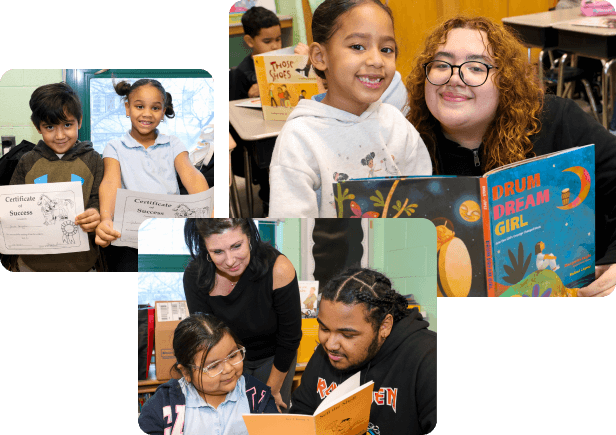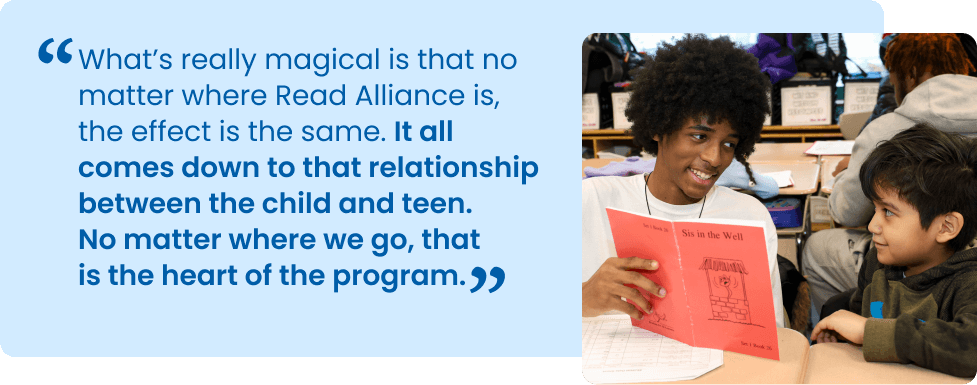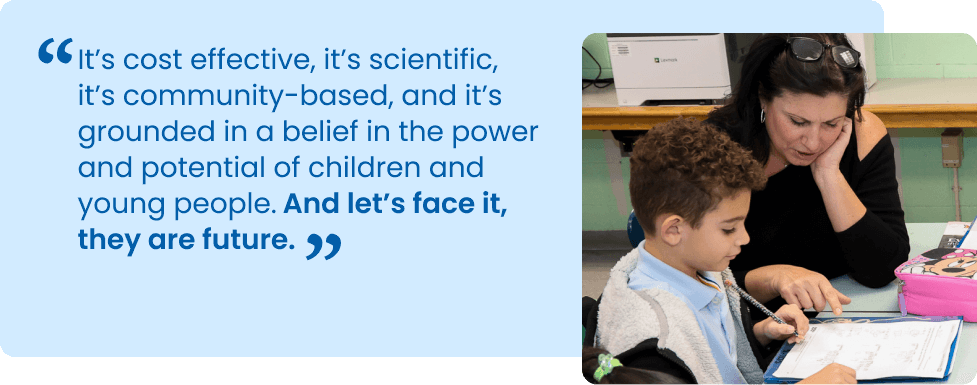In 2000, Read Alliance’s founders piloted a literacy model that brought together a phonics curriculum, struggling young readers and teen reading tutors. Twenty-five years later, Read Alliance has employed more than 20,000 high school youth providing over 22,000 kindergarten, first and second grade students with reading tutoring in low-income neighborhoods in 3 states.
Read Alliance


We spoke with Danielle Guindo, Executive Director of Read Alliance, about how their time-tested program has grown and its expansion plans for the future.

What is the mission of Read Alliance?
Read Alliance trains and pays high school students as individual reading tutors for their younger peers in kindergarten, first and second grades who are struggling to read. More than 85% of participants who complete the program improve more than a grade level in reading and teens gain valuable workforce development and leadership skills – and a paycheck! – in the process.
The need for Read Alliance’s effective intervention is critical. Reading skills across the country have been declining — fewer than one third of students in the United States can read at grade level according to the recent release of the National Report Card. According to an Annie E. Casey Foundation study, not being able to read on grade level predisposes children to be four times more likely to drop out of high school before graduation and increases the likelihood that they face poverty and unemployment in the future. This disastrous economic impact of adults unable to read is far-reaching. According to a 2020 study released by the Barbara Bush Foundation, the US loses $2.2 trillion per year due to adult illiteracy.
Read Alliance is a solution: it is a powerful community empowerment model that promotes the leadership development of young people through the opportunity to serve in a very important role as tutors and role models for younger members of their own communities. The tutors (called Teen Leaders) not only work one-on-one with younger children in a safe environment , they also build skills as mentors and role models for children not much younger than them, with whom they often share similar backgrounds and lived experience. Teen Leaders typically grew up in the same neighborhood and attended the same elementary school as the child. Read Alliance is the first job for more than half of young people who work with us.
Read Alliance’s work is even more imperative after the pandemic, which highlighted the increasingly wide learning deficit between children who have more and children who have less. Read Alliance intends to continue leveling that playing field, and it has every year, wherever we implement programming.

Where does Read Alliance operate?
READ has operated in all five boroughs of New York City for 25 years. Over the past five years, thanks in large part to Customers Bank, we have successfully expanded into Pennsylvania. We are now in year five of a growing program in nine schools in the Reading, Pennsylvania, school district. This spring, we launched in a pilot in Southeast Delco School District, a suburb of Philadelphia, and this coming fall, we are launching a pilot in Buffalo, New York.


What was the catalyst for starting the organization? How has it evolved over time?
Read Alliance was founded by true visionaries. Twenty-five years ago, the founders, who are still very much involved and supportive of READ’s work, realized that too many young children were being written off for being unable to read, and a lot of schools were failing them in their effort to learn. Our founders really believed that each child had the potential to read — it was just a matter of figuring out how different children learn best.
One of the founders, Leah Lebec, identified a curriculum we still use today that is grounded in the science of reading and phonics, which we know empirically is the most effective way to teach early readers. The curriculum was even more ideal because it celebrated reader progress and was easy enough to train teens to implement.
The idea to pair the children with teens in the learning relationship was born from the founders’ involvement at the time with another nonprofit organization that supported teens in finding meaningful community service opportunities. They had an “aha” moment: Wouldn’t it be amazing if these teens learned how to implement this literacy instruction to their younger peers who were struggling to read? They piloted this model during the summer of 2000, and it worked.
We have collected data since day one which has continued to provide that this model works. For 25 years, more than 85% of the young children who complete our program improve at least one grade level in reading. A few years ago, an external evaluator from NYU, nationally recognized literacy expert Dr. Susan Neuman, conducted a study of the Teen Leaders which demonstrated that they also improved a full grade level in foundational reading skills through the process of tutoring. So not only do they earn a paycheck and develop as leaders, but they also improve their own reading skills. It’s a win-win-WIN model!

What sets Read Alliance apart from other organizations?
Dual Impact and Representation.
Read Alliance is the dual impact solution: We advance reading skill improvement for children and teens. We provide job experience and leadership skills for young people. In addition, we have seen the program lead into a pipeline to a teaching career for the Teen Leaders.
Read Alliance is also defined by representation. Inherent in the model is the power of mirroring between the older child to the younger child. The older child is the teacher and the role model, and the little ones learn from their teen mentor. As a result, they begin to show up to class differently, more confident and encouraged, because they know they are making progress in reading and doing so with the mentorship of a big kid who is focused on them.

For those who don’t know about Read Alliance, why is this model distinct?
We want to be very clear about what differentiates our program:
Teens provide the reading intervention, and the teens are paid.
We are empowering young people with incredibly useful workforce and professional development skills. For more than 50% of our teens, Read Alliance is their first job. It is the starting point for them to be able to move forward in life, knowing what it feels like to be relied on and to have a job that means something and impacts others in their own communities.
The intervention is focused on phonics and grounded in science.
We focus on kindergarten, first, and second grades, because research shows the greatest amount of change can take place before the critical third grade year especially when advancing foundational reading skills. We use on a curriculum that emphasizes phonics, which science shows is the most effective way to transform literacy skills at that young age.
The children are reflected in the people around them.
They feel supported, nurtured, encouraged, and it feels like fun. Teachers who work in the READ program are role models for the teen leaders, and the teen leaders are role models for the young READers.
Both groups grow.
And we’re not just saying it. We are measuring and proving it. And we’re really proud of that.

What are you most excited about for the future of Read Alliance?
I am excited for more supporters to mobilize to action when they see that we are a solution. It speaks volumes that we can tell folks who are committed to literacy, children, and education that an investment in Read Alliance is truly a double- or triple impact investment.
I’m equally excited about partners like Customers Bank joining with us in this expansion effort, helping us reach more children and teens who would benefit from our impactful programming.
It’s cost-effective, it’s scientific, it’s community-based, and it’s grounded in a belief in the power and potential of children and young people. And let’s face it, they are our future.


What is one piece of advice you would give to other nonprofit leaders to help them be successful?
Lead with your heart. When you lead with your heart, you know that every move you make is for the right reasons. It streamlines decision-making because you save a lot of time and energy second-guessing your choices.
And make sure you are connected to other supporters leading with their hearts, so you know everyone joined with you is deeply connected to purpose. If you have to question someone’s motives, or if others are not as aligned as you are, that distracts from the goal.
And in our case, our purpose is making sure children learn to read and helping empower teens to learn to lead.